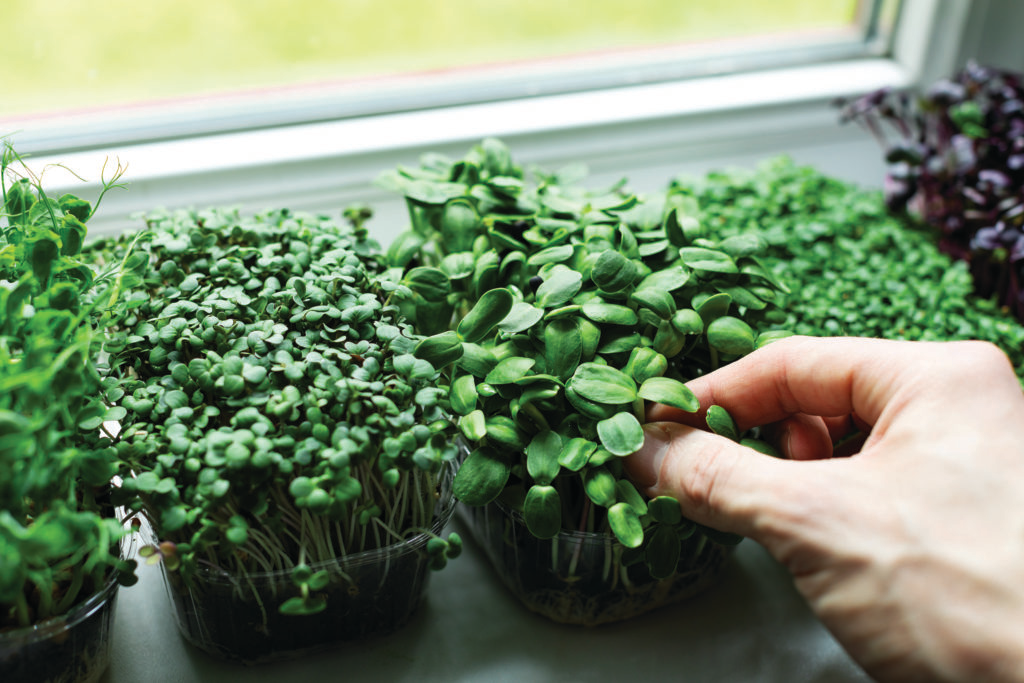By Katie Jackson
Microgreens, those tiny delicate plants that often adorn upscale restaurant dishes, are hugely popular in culinary circles and can also be an enormously fun crop to grow at home.

Though microgreens may look like exotic lilliputian plant species, they are actually nothing more than seedlings of everyday edible plants such as lettuces and leafy greens, vegetables, herbs, flowers, grasses and grains. However, because they are harvested at tender ages (often within a week or two after planting) microgreens possess unique characteristics that set them apart from their elders.
First embraced in the 1980s by San Francisco-area chefs, they were used to add color, flavor, texture and charm to a wide variety of dishes — from appetizers and main courses to desserts and even smoothies. Turns out, these darling little garnishes were not just pretty, they were healthful and nutritious. In fact, some species contain 40 times the concentration of vitamins, minerals and antioxidants than their mature relatives.
Today, microgreens are increasingly easy to find at retail groceries, farmers markets and specialty food stores, and Alabama has at least two small-scale commercial microgreen growers who ship trays of ready-to-harvest microgreens straight to your door.
However, microgreens are also perfect for home gardening. They can be grown outside in garden beds (just make sure the area can be protected from extreme temperatures, strong winds and hungry critters) or can be grown inside or out in containers. They are easy enough for children and beginning gardeners to grow with great success but intriguing enough to make them fun for more experienced gardeners, too. And because they require very little space, microgreens are ideal for apartment dwellers or anyone with limited gardening space.
A wide selection of microgreen starter kits (complete with seed, growing media and growing trays) is available online and in many garden stores and centers. But a microgreen garden is easy to create from scratch, too, using almost any kind of shallow container, including upcycled plastic take-out containers, aluminum pie plates and the like. Fill the container with an inch or so of high-quality potting soil or a sterile soilless growing medium, sprinkle seeds (see a plant list below for ideas) evenly across the growing medium’s surface, cover with a thin (1/8-inch or so) layer of soil or medium and press the surface lightly to secure the seeds in place.
Water gently but thoroughly and place the container in a warm (preferably 65-75 degrees) location with access to sufficient light — typically four to six hours each day for most species though this may vary depending on the type of green you’re growing. Keep the soil or growing medium moist, but not wet, by misting the surface once or twice each day (more frequently if soil shows signs of drying out) and watch as your microgreens emerge.
As they germinate, the seeds will first develop cotyledons (seed leaves), followed by a second set of “true” leaves, a process that can take a week or two depending on growing conditions and plant species. When the second set of leaves develops, the plant should be an inch or two in height and ready for harvest — simply snip their stems right above the soil level. Harvested microgreens can be kept in the refrigerator for several days but are at their best when snipped and rinsed just before use.
Once a crop is harvested, another crop can often be replanted into the existing soil or growing medium, though if the medium has become moldy it’s better to start fresh. Planting successive crops, you can have a steady supply of microgreens every couple of weeks, and once you get the hang of it, you can experiment with different kinds of plants to find ones that fit your skills and tastes.
February Tips:
- Plant new roses and prune existing ones.
- Sow seed for early spring vegetables and flowers.
- Make plans for the coming gardening season.
- Start preparing garden tools and equipment for spring activities.
- Clean and refill bird feeders and baths.
- Test soils in lawns and garden beds and amend based on results.
- Pamper houseplants as they get ready for spring.
Microgreen plant list
Microgreens can be grown from the seeds of many different kinds of edible plants, but make sure to use organic and/or untreated seed; larger seeds may need to be soaked for better germination.
- Lettuces and Greens: Arugula, Chard, Collards, Kale, Spinach
- Herbs: Basil, Cilantro, Dill, Mints, Oregano, Sage, Thyme
- Vegetables: Beets, Beans, Broccoli, Cabbage, Cauliflower, Peas, Radishes
- Flowers: Chrysanthemum, Sunflower, Nasturtium
- Grasses and Grains: Alfalfa, Barley, Buckwheat, Flax, Wheatgrass
Katie Jackson is a freelance writer and editor based in Opelika, Alabama. Contact her at [email protected].




